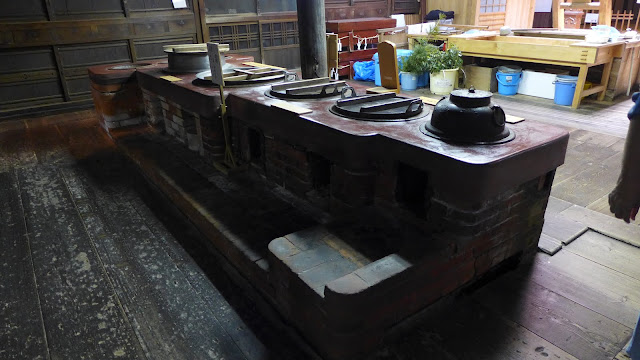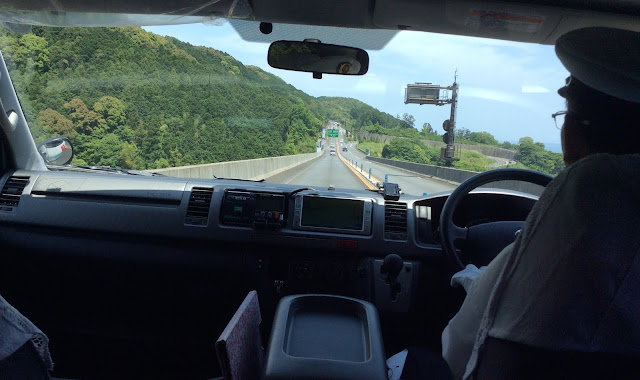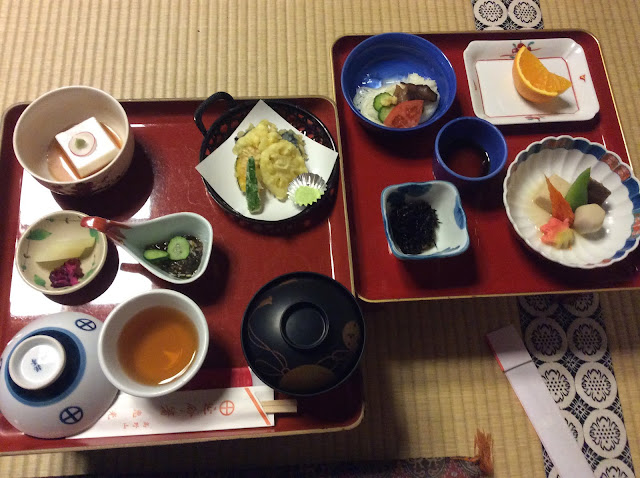Wanting to relax from the (uphill) rigours of the Kumano Kodo and yet not wishing to see our pilgrimage end, I arranged for a post-Kumano visit to Mt. Koya, the holiest mountain of Shingon Buddhism. The mountain is directly connected to the Shinto pilgrimage as it is one of the five routes that pilgrims used to and continue to walk on to this very day.
We woke up very early to get ready for the 6:30 morning sutra chanting service at our shukubo (temple lodging). There was enough time to walk around the grounds of Eko-in and enjoy the early morning quietude.
The giant peonies were in full bloom in the garden.
Masses of pink rhododendrons with their light delicate fragrance grew all around the temple.
In one corner of the yard is an inari shrine -- not at all unusual to find a Shinto shrine in a Buddhist temple or vice versa.
We were the first to enter Eko-in's main hall for the sutra chanting service. The monks do this on a daily basis, chanting the Heart Sutra, among others.
Jay and I had attended this before and it is an extraordinary experience. The rhythmic chanting with the beating of the gong puts me in a meditative state and at that moment, everything else is blocked out.
Jay and I had attended this before and it is an extraordinary experience. The rhythmic chanting with the beating of the gong puts me in a meditative state and at that moment, everything else is blocked out.
After the chanting, we are invited to come and offer incense and bow before the Buddha. Almost everyone participates. It is a solemn and moving experience.
The morning service takes about half an hour but I hardly notice the time ... it seems to go by so fast. Afterwards, guests are invited to a small building just outside the gate of Eko-in for the next morning ritual.
This is the goma or the fire ritual that is performed In Eko-in and a few other temples in Koyasan, every single morning. Small wooden plaques or goma-ki with wishes and prayers written on them are burned along with incense as an offering.
As the fire continues to grow and blaze in the the darkened room, it literally brings us out of the
dark and into the light.
As the fire continues to grow and blaze in the the darkened room, it literally brings us out of the
dark and into the light.
The goma ritual ends as the fire slowly dies down to embers. We silently file out and head to our respective rooms where breakfast is waiting. Each one of us gets a tray of shojin ryori or temple vegetarian cuisine and it seems almost ascetic in appearance.
There is a small portion of rice, a disk of boiled tofu mixed with herbs, some simmered greens, pickles and bowl of miso soup. I savour the roasted rice tea that is served instead of coffee.
There is a small portion of rice, a disk of boiled tofu mixed with herbs, some simmered greens, pickles and bowl of miso soup. I savour the roasted rice tea that is served instead of coffee.
After breakfast, time to head out to see more of Koyasan.
Since we have friends who are first time visitors, I asked Chieko san, a good friend and an excellent Tours by Locals guide to show us around. This way, our friends can have a better understanding of the historical, cultural and spiritual background of Mt. Koya.
Since we have friends who are first time visitors, I asked Chieko san, a good friend and an excellent Tours by Locals guide to show us around. This way, our friends can have a better understanding of the historical, cultural and spiritual background of Mt. Koya.
Our first stop is the head temple of Shingon Buddhism, the Kongobu-ji. These lovely stone steps lead to the main gate of the temple grounds.
Upon entering, you will notice this graceful wooden structure, this is the shoro or the bell tower. Notice the intricately carved beams on its upper levels.

This beautiful wooden building is the head temple of the hundreds of Shingon Buddhist temples in Japan and all over the world.
It was originally built when Kobo Daishi established this sect of Buddhism in the ninth century but has been destroyed by fire many times.
The entrance on the left that you see protected by a small wooden fence is reserved for members of the Imperial Family, the chief abbott and other high ranking monks.
The entrance on the right where you see the white wooden sign is where visitors like us are allowed to enter.
Do you see the pails on the small wooden structures on the roof? These are meant to gather rainwater which can be used to help protect the building from fire. But since the temple has burned down so many times, I wonder just how much protection these rain buckets give?
We are free to walk around most of the areas except for the main hall and other spaces which are used only for important ceremonies.
While Kongobu-ji, like all of Koyasan, is a UNESCO World Heritage Site, it is also an active and working temple where monks and other people continue to live and work.
While Kongobu-ji, like all of Koyasan, is a UNESCO World Heritage Site, it is also an active and working temple where monks and other people continue to live and work.
Our guide Chieko san pointed out this enormous kitchen with its super sized cooking pots and stoves which she said used to provide meals for as many as 2,000 monks in the olden days.
I sympathise with the poor souls who had to wash all the dishes afterwards.
Outside the temple building is the largest rock and sand garden in all of Japan. Stretching out over an area of 2,400 square meters, it was completed in the 12th century.
The garden is called Banryu-tei and it features 140 massive rocks meant to symbolise two large dragons rising from the sea to guard the temple.
Perhaps you can't visualise it from this photo but as I stood there marvelling at this impressive garden from different angles, I could imagine a head, a tail ... until I could see what the garden designer wanted me to see.
These heavy rocks came all the way from the island of Shikoku where Kobo Daishi was born.
The meticulously raked sand came from Kyoto. I cannot imagine how the gardener who designed this managed to bring all those materials up to Mt. Koya, way before 18 wheeler trucks were invented.
The meticulously raked sand came from Kyoto. I cannot imagine how the gardener who designed this managed to bring all those materials up to Mt. Koya, way before 18 wheeler trucks were invented.
A striking patch of carefully pruned and arranged shrubbery is a refreshing sight amidst the dazzlingly white raked sand.
From the Kongobu-ji, it is a pleasant walk under perennially red Japanese maples to our next stop ... the Danjo Garan temple complex.
If Kongobu-ji is the headquarters of Shingon Buddhism, the Danjo Garan is the heart of the religion as this is where Kobo Daishi initially established the sect in 816.
Together with the Okunoin, the Danjo Garan is considered as a most sacred space in the mountain.

We entered via the side gate and the first imposing structure that we saw was the Toto or
the Eastern Stupa.
This maroon painted wooden pagoda is a reconstruction as the original one burned down in
the 1800s.
the Eastern Stupa.
This maroon painted wooden pagoda is a reconstruction as the original one burned down in
the 1800s.
Danjo Garan was used by Kobo Daishi as the training centre for his monks. There are many important buildings within the grounds. Today, the Danjo Garan is used for special ceremonies
and to commemorate important occasions.
and to commemorate important occasions.
This beautifully preserved wooden building called the Fudodo was constructed in 1197 and is one of the oldest original structures in Koyasan. I am amazed that it has not been destroyed by fire.
The Fudodo was designed and built by four different artisans so each side is different from the next. Because of this architectural oddity and its ancient history, it is a National Treasure of Japan.
I breathe a silent prayer that it may forever be spared from fire or any disaster.
The blindingly vermillion pagoda is known as the Konpon Daito or the Great Stupa. It is also one
of the most recognised buildings in Koyasan.
For a small fee, you can enter to view the statues and images inside. Unfortunately, photos are not allowed inside so I can't share any with you.
In front of the Great Stupa is the Kondo or the main hall. This has been burnt and rebuilt many times. It is the site for many traditional Buddhist services and is also the largest building in the
Danjo Garan complex.
We wind down our visit to Danjo Garan by the new gate in front of the Kondo.
I do not recall seeing this during my first visit and Chieko san said it had been constructed in the
last 3 years.
It has been a hot and sunny morning and we take a break for lunch. Of course I indulge in an
ice cold glass of nama beer. This is the real pause that refreshes!
We have just a few hours left before we have to take the train down to Kyoto. While we did walk through Okunoin last night, a stroll during daylight allows you to see and appreciate the many interesting things in this largest cemetery in Japan.
Aside from the hundreds of thousands of people buried in the cemetery, Japanese companies also own memorial plots where their founders, officers or even some employees can choose to be buried. Some of the corporate plots give the visitor an idea of what the company's products or services are ... much like this one marked by a statue of a rocket -- perhaps this belongs to a company involved in products for space technology.
Fans of the lacto bacilli drink will definitely recognise whose memorial plot this is.
How about some blended coffee? I do see a very large coffee cup!
This must have been such a beloved family pet. Man's best friend is also his eternal companion.
One of the most popular and visited memorial plots is this one belonging to a pest control company. The memorial is dedicated to the millions of termites and other pests that the company has "exterminated". As Buddhists believe that all life is sacred, the company has put up this mausoleum in their memory.
Even in early afternoon, the shaded paths of Okunoin provide a palpable sense of tranquility. Because the place is so large, you will often find yourself alone, with no one to intrude on your thoughts.
In this graveyard, one cannot feel sad or morbid ... Okunoin is a place where you can walk, reflect on your life and the different paths you take along your journey.
My favourite of Kobo Daishi's teachings states that there is a Buddha within all of us. The monk in Eko-in told me that when I think of Kobo Daishi, he will be there with me.
Dogyo Ninin.
We two, travelling together.
P.S.
I am always happy to see Chieko san, an excellent Tours by Locals guide (and who has since
become a good friend). She has walked with us through many temples and shrines these past years.
Her knowledge and experience were invaluable in helping us better appreciate the treasures of Koyasan.
Lessons Learned
1. The most important areas in Koyasan are the Okunoin, Danjo Garan and Kongobu-ji. Do not miss out on seeing them.
If there is time, there is a very interesting museum you may want to visit.
2. There are two bus lines that crisscross the main streets. Taxis are also available. You may also rent bikes from the tourist centre.
3. At the funicular station that will take you down to the train headed back to Osaka, there is a takyubin or parcel counter that can forward heavy luggage to your next destination ... be it the airport or a hotel. Please note that it takes at least 24 hours for your luggage to be delivered.
become a good friend). She has walked with us through many temples and shrines these past years.
Her knowledge and experience were invaluable in helping us better appreciate the treasures of Koyasan.
Lessons Learned
1. The most important areas in Koyasan are the Okunoin, Danjo Garan and Kongobu-ji. Do not miss out on seeing them.
If there is time, there is a very interesting museum you may want to visit.
2. There are two bus lines that crisscross the main streets. Taxis are also available. You may also rent bikes from the tourist centre.
3. At the funicular station that will take you down to the train headed back to Osaka, there is a takyubin or parcel counter that can forward heavy luggage to your next destination ... be it the airport or a hotel. Please note that it takes at least 24 hours for your luggage to be delivered.


















































